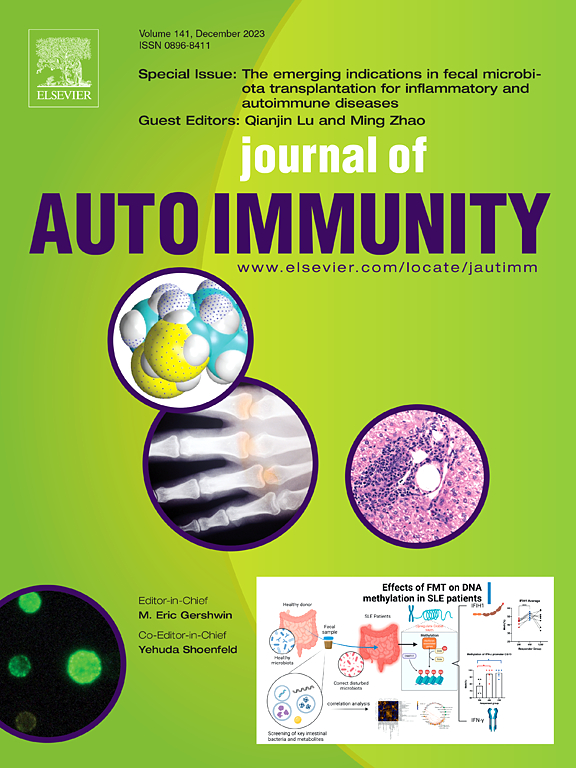Microbial dysbiosis fuels STING-driven autoinflammation through cyclic dinucleotides
IF 7
1区 医学
Q1 IMMUNOLOGY
引用次数: 0
Abstract
Aberrant activation of the stimulator of interferon genes (STING) pathway is a hallmark of autoinflammatory disorders such as STING-associated vasculopathy with onset in infancy (SAVI), characterized by systemic inflammation affecting blood vessels, skin, and lungs. Despite its clinical significance, the mechanisms linking STING activation to disease pathology remain poorly defined. In this study, we demonstrated that SAVI mice harboring the N153S STING mutation exhibit diverse disease phenotypes, with a subset developing severe colitis and diarrhea alongside exacerbated systemic inflammation. These diarrheal SAVI mice showed pronounced dysbiosis, marked by reduced short-chain fatty acid-producing bacteria and an enrichment of segmented filamentous bacteria. This microbial imbalance was accompanied by elevated levels of both microbial and host-derived cyclic dinucleotides (CDNs), potent activators of the STING pathway. Notably, antibiotic treatment ameliorated inflammation, underscoring the role of dysbiosis in driving STING-mediated autoinflammation. Furthermore, in SAVI patients, elevated systemic microbial and host-derived CDNs were observed. In conditions such as systemic lupus erythematosus (SLE)—a heterogeneous autoimmune disease with potential STING involvement—systemic microbial CDNs were significantly correlated with disease biomarkers, including type I interferon scores and anti-dsDNA antibodies. In contrast, no such correlations were observed in STING-independent conditions like rheumatoid arthritis (RA). Importantly, this study highlights that both microbial and host-derived CDNs are key drivers of STING activation, suggesting that personalized treatment strategies could target cGAS or the microbiome based on a patient's specific CDN profile. These findings position systemic CDNs as valuable biomarkers and therapeutic targets for STING-driven diseases.

微生物生态失调通过环二核苷酸刺激sting驱动的自身炎症
干扰素刺激因子(STING)通路的异常激活是自身炎症性疾病的一个标志,如婴儿期发作的STING相关血管病变(SAVI),其特征是影响血管、皮肤和肺部的全身性炎症。尽管具有临床意义,但将STING激活与疾病病理联系起来的机制仍不清楚。在这项研究中,我们证明了携带N153S STING突变的SAVI小鼠表现出多种疾病表型,其中一个亚群发展为严重的结肠炎和腹泻,并伴有加重的全身炎症。这些腹泻的SAVI小鼠表现出明显的生态失调,其特征是短链脂肪酸产生细菌减少,节段丝状细菌丰富。这种微生物失衡伴随着微生物和宿主衍生的环二核苷酸(cdn)水平的升高,cdn是STING途径的有效激活剂。值得注意的是,抗生素治疗改善了炎症,强调了生态失调在驱动sting介导的自身炎症中的作用。此外,在SAVI患者中,观察到系统微生物和宿主来源的cdn升高。在系统性红斑狼疮(SLE)——一种可能涉及STING的异质性自身免疫性疾病——等情况下,系统微生物cdn与疾病生物标志物(包括I型干扰素评分和抗dsdna抗体)显著相关。相比之下,在与sting无关的情况下,如类风湿关节炎(RA),没有观察到这种相关性。重要的是,这项研究强调微生物和宿主来源的CDN都是STING激活的关键驱动因素,这表明个性化治疗策略可以基于患者特定的CDN特征来靶向cGAS或微生物组。这些发现将全身性cdn定位为有价值的生物标志物和sting驱动疾病的治疗靶点。
本文章由计算机程序翻译,如有差异,请以英文原文为准。
求助全文
约1分钟内获得全文
求助全文
来源期刊

Journal of autoimmunity
医学-免疫学
CiteScore
27.90
自引率
1.60%
发文量
117
审稿时长
17 days
期刊介绍:
The Journal of Autoimmunity serves as the primary publication for research on various facets of autoimmunity. These include topics such as the mechanism of self-recognition, regulation of autoimmune responses, experimental autoimmune diseases, diagnostic tests for autoantibodies, as well as the epidemiology, pathophysiology, and treatment of autoimmune diseases. While the journal covers a wide range of subjects, it emphasizes papers exploring the genetic, molecular biology, and cellular aspects of the field.
The Journal of Translational Autoimmunity, on the other hand, is a subsidiary journal of the Journal of Autoimmunity. It focuses specifically on translating scientific discoveries in autoimmunity into clinical applications and practical solutions. By highlighting research that bridges the gap between basic science and clinical practice, the Journal of Translational Autoimmunity aims to advance the understanding and treatment of autoimmune diseases.
 求助内容:
求助内容: 应助结果提醒方式:
应助结果提醒方式:


